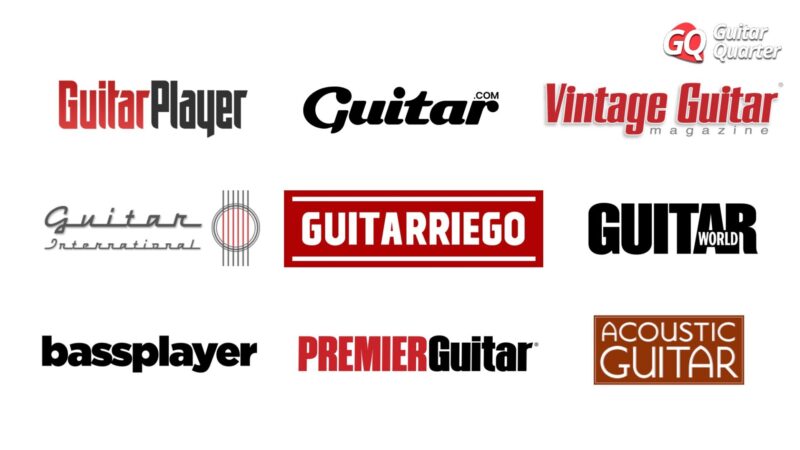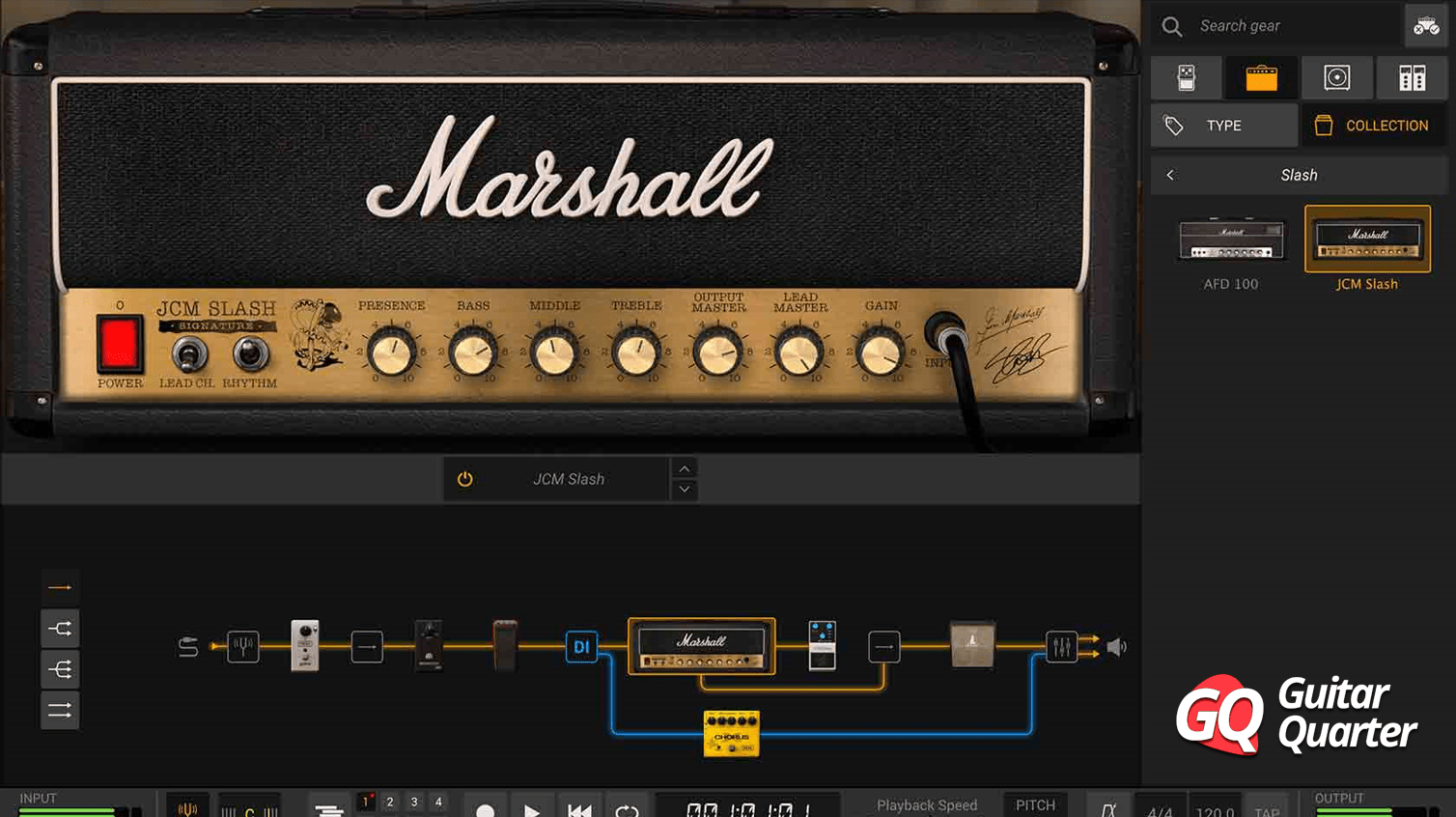Guitar Sizes: electric, acoustic and classical guitars for children and adults

Guitar sizes have a great impact on the playability and comfort whether it is acoustic, electric or Spanish classical, we guide you on how to choose the size of a guitar for children and adults.
Table of Contents
The size of guitar: importance and impact
Comfort and playability according to the dimensions of a guitar
Guitars come in different sizes and these have a huge impact on the playability of the guitar. Therefore, it is important to choose the right size guitar for each guitarist. Thus, the ideal size of an electric, acoustic or classical Spanish guitar will vary depending on whether the guitarist is a child, adult, tall, short, the size of their hands and fingers, etc.
Tonal characteristics of the instrument according to the size of the guitar
Perhaps, if you are a beginner, this section is not relevant for you. However, if you already have some experience or are a beginner looking for a certain sound or tone on your electric, acoustic or classical guitar, it is important that you know the tonal characteristics that the different guitar sizes give. This is explained later.
Check out our guide to the best easy guitar songs for beginners.

Relationship between guitar size and weight
In addition to size, it is important to consider weight. It is important to note that the size of the guitar does not always have a direct relationship to the weight. For this reason, we suggest you read this guide on guitar weight: how much each of the electric guitar models weighs. Thus, it is a good idea to understand how much the weight of guitars can vary. Since very often the size of a guitar can be a misleading indicator of the weight of a guitar.
Purpose of this guide on guitar sizes and measurements
In this guide, we answer the main questions you should ask yourself about guitar sizes. In this way, you will be able to choose the best size guitar for the different needs, ages, height and tastes of a guitarist. Also, the information contained on the sizes and measurements of the guitars will help you when buying the case for your guitar or a piece of furniture to store your instrument.
How to measure a guitar
To get started, let’s look at how to measure a guitar. Thus, you have to know what things are measured about acoustic, classical and electric guitars. In this way, we will be able to accurately compare different sizes of guitars.
The main way to measure acoustic, classical, and electric guitars is scale length. Although knowing the total length of a guitar is useful, especially when it comes to knowing its place and where we will store it. Knowing the length of the scale is the most important measurement of any electric, acoustic and classical Spanish guitar.
Also, we recommend that you visit our tutorial of easy Country songs for beginners, ideal for playing on acoustic guitar.
Measure the scale length of a guitar
Scale length is the most important measurement for a guitar because it affects the feel of a guitar when you play it. This measure of the guitar defines the distance between each of the frets. So if you have small hands, you may be more comfortable with a short scale guitar. Or maybe, on the contrary, you prefer that the frets are not so close to each other, and you would like more guitars with a long scale.
The scale length of a guitar is measured by measuring the distance from the bridge to the nut of the guitar, as shown in the following images of the different types of guitar:
Scale length image of an electric guitar
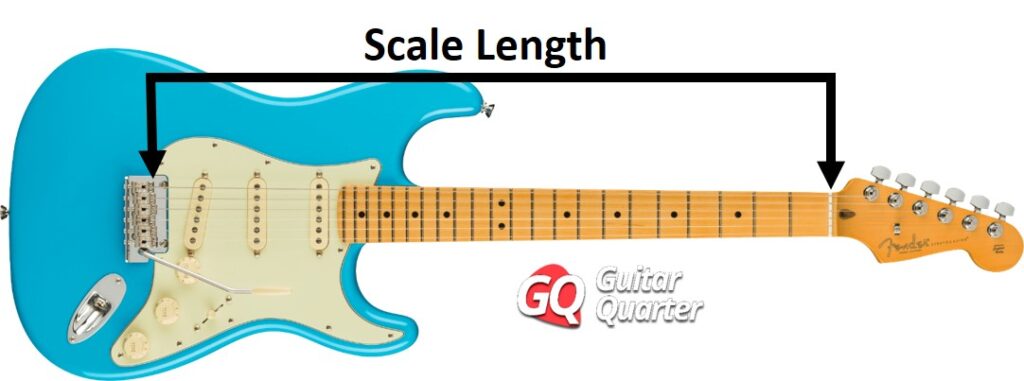
Electric guitars do not have a straight bridge, what’s more they usually have mobile saddles for each string. Thus, the criteria changes, some take the average, others take the distance of the nearest string. This means that sometimes the measurement can vary a few millimeters, although it is the same scale.
Scale length image of an acoustic guitar

Acoustic guitars bridges have a small inclination, which makes each string have a different distance from the bridge, the average or the mid point is usually taken for measurement.
Full scale image of a Spanish classical guitar
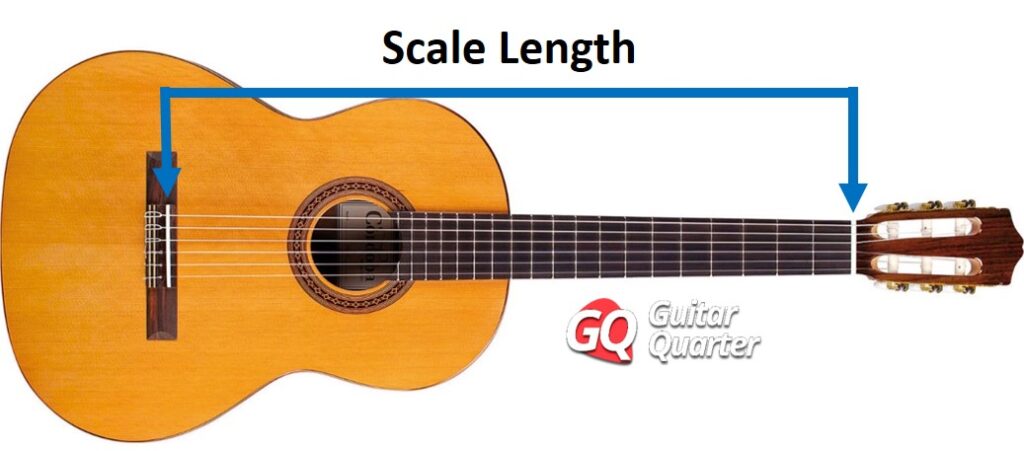
Influence of the guitar scale on comfort and playability
Relationship between scale length and guitar string tension
In addition to defining the distance between the different frets on the guitar, the scale length influences the tension of the strings. The longer the scale length, the higher the tension, the shorter the scale length, the lower the tension. Thus, the higher the tension, the harder the strings feel and the more force you require to press a note and especially for bendings. For this reason, there are many guitarists who use a smaller string gauge on their 25.5″ long scale Fender guitars than on their 24.75″ short scale Gibson guitars.
You might be interested in our tutorial on guitar string names: notes, letters and numbers.
Relationship between scale length and guitar sound: attack and sustain
In turn, the tension of the strings influences the sound response of the guitar. The higher the tension, the faster the strings stop; on the contrary, the lower the tension, the longer the strings vibrate. Thus, short scales tend to have more sustain, while long scales have more attack, and feel more dynamic and nuanced.
So, as you can see, the choice of scale length is not only a matter of comfort and playability of the guitar. Also, the length of the guitar scale defines the sound of the guitar. In fact, scale length is a fundamental part of the characteristic tone of Fender and Gibson guitars.
Measure the overall length of a guitar
When we measure the overall length of a guitar, we measure from the top of the headstock to the bottom of the body. But the length of a guitar is not a relevant measurement for the comfort or playability of the guitar. The total length is a useful measure to know the dimensions required by the case and the storage space as in the case of a piece of furniture.

How to measure the total length of a Spanish electric, acoustic and classical guitar
Take a tape measure and line it up along the strings. Overall length is the measurement from the end of the body to the tip of the headstock, as shown in the images below for electric, acoustic, and classical Spanish guitars.
Full length image of an electric guitar
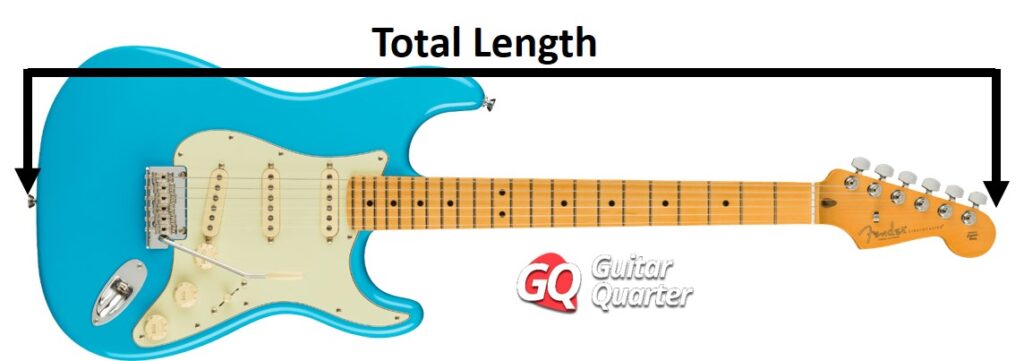
You may be interested in our review of the best and worst Fender Stratocaster according to their year of manufacture.
Full length image of an acoustic guitar

Full length image of a Spanish classical guitar
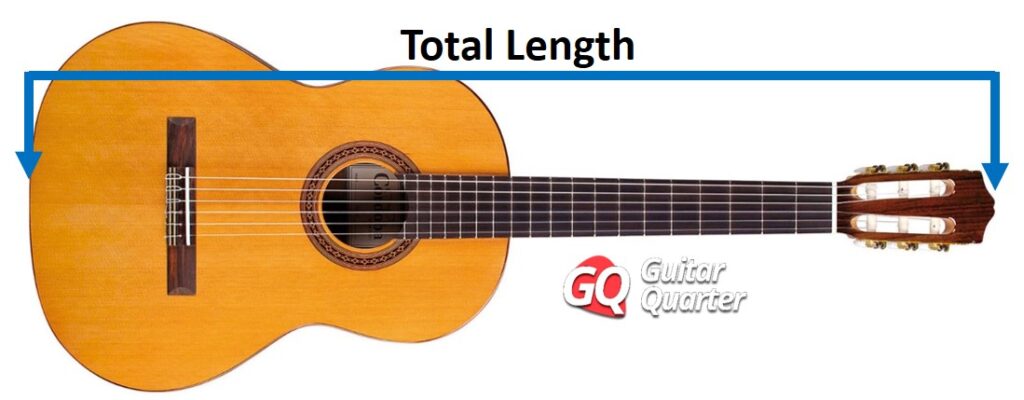
If you take a look at the pictures above of the different types of guitars, you will notice that each type and model of guitar has a different body shape. In addition, there are even different models and classes of electric, acoustic and classical guitars that differ in length from each other. For this reason, the measurements of total length of the different guitars vary a lot between the different models. Typically, the overall length of a “full size” guitar can range from 36 inches or 90 cm to over 40 inches or 102 cm. Thus, there is no standard overall length for the guitar because there are so many different types of guitars.
Relationship between the normal length of the guitar and the sound
There is no clear relationship between the total length of the guitar and its sound. But there is a relationship between total body size and sound. Thus, larger guitars tend to sound with more mids and lows, so the sound is “bigger” too.
Don’t forget to also visit our guide on the guitar CAGED system.
What is the size of a “full size” guitar?
The term ‘full size’ guitar is a standard measurement for classical nylon string and acoustic guitars. Thus, the length of a full or 4/4 size guitar is normally 39 / 39.5 inches or 99 / 100 cm. Anyway, electric guitars also uses this criteria for grouping the different sizes.
What are the different sizes of guitars?
While there are many different sizes when it comes to guitars, there are common and standard guitar sizes. Knowing the typical size of different types of guitars can help you figure out which one is right for you or your child.
Electric guitar sizes
The standard sizes for electric guitar are four. In the image below we detail the scale measurements, total length of the electric guitars and for the ages and heights of children or adults for which they are recommended.

Acoustic guitar sizes
Below, you will see the standard sizes for acoustic guitar. In the image we detail the scale measurements, total length of the acoustic guitars and for the ages and heights of children or adults for which they are recommended.

Classical guitar sizes
The standard sizes for nylon string classical guitar are four. In the image below we detail the scale measurements, total length of classical guitars and for the ages and heights of children or adults for which they are recommended.
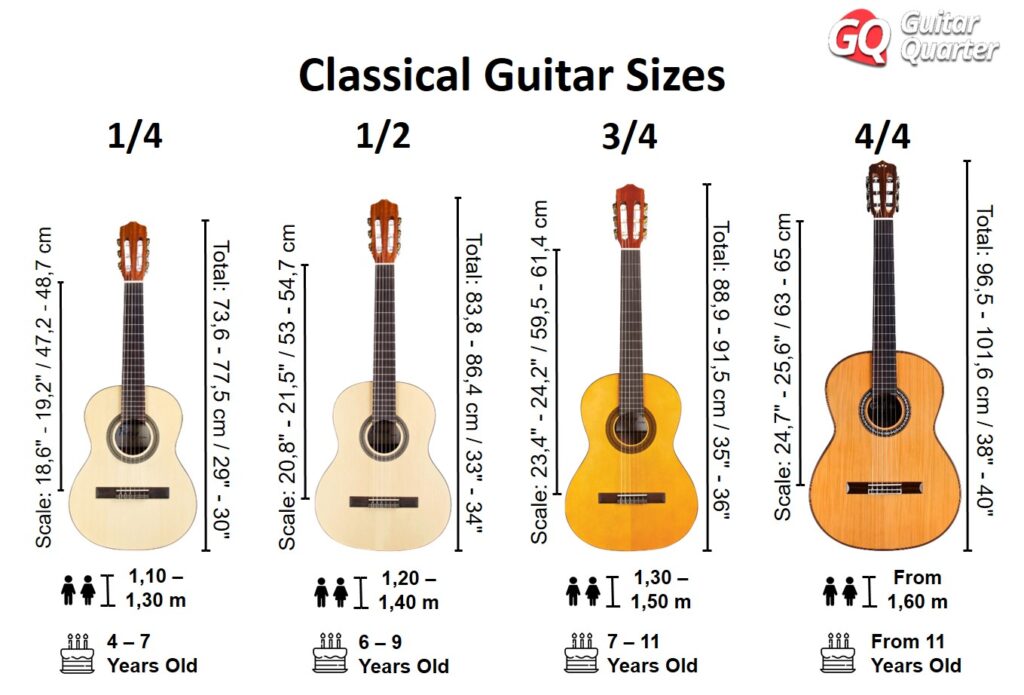
Guitar sizes: 4/4, 3/4, 1/2 and 1/4
The 4/4 size electric, acoustic and classical guitars shown above are full size guitars. The other three sizes of guitars are scaled-down versions. In addition to the four standard sizes, there are also two other sizes offered mainly by acoustic and classical guitar manufacturers: 1/8 and 7/8. Summarizing, the guitar sizes, the scales in cm and inches and the suggested heights for each size are shown in the following table:
| Guitar sizes | 1/8 size or guitarlele | 1/4 Size | 1/2 Size | 3/4 Size | 7/8 Size | 4/4 Size or Full-sized |
| Suggested height | Up to 1.10m | 1.10 – 1.30m | 1.20 – 1.40m | 1.30 – 1.50m | 1.40 – 1.60m | From 1.60m |
| Scale length in cm | 39.7 – 41cm | 18-19″ (46.7-48.7cm) | 53-54.7cm | 59.5 – 61cm | 61 – 63cm | 61 – 65cm |
| Scale length in inches | 15.6″ – 16.5″ | 18.4″ – 19.2″ | 20.8″ – 21.5″ | 23.4″ – 24″ | 24″ – 24.8″ | 24″ – 25.6″ |
While it would make sense for a 1/2 size guitar to be half the size of a full-sized guitar, you can clearly see from the photo above that this is not the case. The naming system used with classical and acoustic guitars can be a bit misleading.
Thus, a 1/4 guitar isn’t really a quarter size compared to a full size guitar. A typical 1/4 scale guitar has a scale length of 48 cm or 19 inches and an overall length of around 78 cm or 31 inches.
So the point to remember here is that the names are just trying to simplify the different options.
We recommend that you visit the ranking of the best cheap acoustic guitars for adults and beginner teenagers.
1/4 size guitar
The smallest standard size is the 1/4 guitar. The 1/4 size guitars are ideal for children ages 4-7.
1/4 size guitars have a scale length ranging from 18.6″ / 47.2 cm to 19.2″ / 48.7 cm. They are designed for children from 1.10 m to 1.30 m tall.

1/2 size guitar
The following guitar size is the 1/2. These are medium guitars that indicated for children from 6 years old to 9 years old.
1/2 size guitars have a scale length ranging from 20.8″ / 53 cm to 21.5″ / 54.7 cm. They are designed for children from 1.20 m to 1.40 m tall.
3/4 size guitar
The 3/4 guitar size is ideal for children ages 7 to 11, and even adults who prefer a smaller instrument.
3/4 size guitars have a scale length ranging from 23.4″ / 59.5 cm to 24.2″ / 61.4 cm. They are designed for children and adolescents from 1.30 m to 1.50 m in height. Although they are also widely used by female guitarists or adult guitarists with small hands.
Full-sized or 4/4 guitar
Finally, there is the 4/4 or full-size guitar that is indicated for children 11 and older and adults.
4/4 size guitars have a scale length ranging from 24.8″ / 63 cm to 25.6″ / 65 cm. Full-size guitars are sized for people over 5’6″ tall.
Also, you might be interested in knowing what are the rarest and most collectible electric guitars in the world?
Other popular guitar sizes
The guitar sizes that we saw before are the traditional and standard measurements of the classical and acoustic guitars. But manufacturers, seeking to cover more market niches, have developed new acoustic and classical guitar sizes.
1/8 size guitar, or Guitarlele

Thus, an even smaller size of guitar appears, which is the guitarlele. The 1/8 guitar or guitarlele is smaller than standard in size, similar to the size of a ukulele. Thus, the name is a play on words between guitar and ukulele.
1/8 size guitars have a scale length ranging from 15.6″ / 39.7 cm to 16.5″ / 41 cm. This guitar size is designed for children from 3 to 5 years old or up to 1.10 m tall. Although they are also widely used as a travel guitar by adult guitarists.
The guitarlele is similar in size to a ukulele but has six strings and they are tuned like the fifth fret of a common guitar, as shown below:
| Guitarlele String | 6 | 5 | 4 | 3 | two | one |
| Note | A | D | G | C | AND | A |
7/8 size guitar
This size is somewhere in the middle between 3/4 and full size (4/4) guitar. Acoustic and classical guitar manufacturers developed this model for teenage, female, and adult guitarists with small hands.
7/8 size guitars have a scale length ranging from 24.4″ / 62 cm to 24.8″ / 63 cm. They are designed for children from 10 years old and adolescents from 1.40 m to 1.60 m tall. Although they are also widely used by adult guitarists with small hands and women.
Thus, if we put together all the most popular sizes of acoustic and spanish classical guitars, we are left with the following summary according to the graph below:

If you have a guitar and want to know if it is a full size guitar, the first thing to check is the scale length. If the scale length is around 25 inches or more than 25 inches, it’s probably a full-size guitar.
You may be interested in our guide about the Fender Jaguar specifications and history.
Travel guitars

Travel guitars are very small guitars. Although some travel guitars have a shorter scale length, there are also some that maintain a full-size scale length. Each manufacturer has different versions and sizes of travel guitars, and there is no single standard of measurements.
3/4 guitar vs full size
This is a very common question among female or male guitarists with small hands. The main differences between a full sized acoustic guitar vs a ¾ guitar are the dimensions. While the full size acoustic guitars usually have a scale length of 24.7″ to 25.6″ and a total length of 38″ to 42″, the ¾ guitars usually have an scale of 23.4″ and 24.2″ and a total length of 35″ to 36″.
Additionally, the 4/4 guitars has the dimensions of 40 x 15 inches, whereas the dimensions of a 3/4 size guitar around 36 x 13 inches.
Thus, the 3/4 and also the 7/8 are very used guitars among women and men with small hands.
Acoustic guitar soundboard sizes and shapes
Also, you can find acoustic guitars with different sizes of soundboard. Thus, there is the Concert guitar that has a larger resonance box to be able to achieve greater volume, precisely to play in concerts. But this type of guitar is considered within the group of Full Size guitars. If you want to know more about the different shapes of acoustic guitars, visit our guide to types of guitars.

What size guitar does a child need?
As we have already seen, the size of a guitar is essential for any guitarist, especially for a child. A full-size dreadnought acoustic guitar may be impossible for a small child to play.
Thus, the younger a child is, the smaller the guitar must be in order to play comfortably. 1/2 and 1/4 size guitars are commonly used for children as they are much easier to play.
Here are some general rules on what guitar size to buy for children based on age and height:
- 1/8 size or guitarlele: up to 5 years or 1.10 m tall.
- 1/4 size: from 4 to 7 years old or from 1.10 to 1.30 m tall
- 1/2 size: from 6 to 9 years old or from 1.20 to 1.40 m tall
- 3/4 size: from 7 to 11 years old or from 1.30 to 1.50 m tall
- 7/8 size: from 10 years old or from 1.40 to 1.60 m tall
- Full size: from 11 years old or 1.60 m tall
You will find different recommendations on the guitar sizes and the age of the child, and all are valid, since it depends on the size of the child. Thus, given that there are countries where the average height is less than the world average, the recommendation changes with respect to a country with the highest average height. For this reason, we also include the height to have a more accurate reference. Here, we recommend that when in doubt buy the largest guitar size, but do not exaggerate, otherwise you will hinder the child’s learning.

Buying advice for a guitar for a child
Don’t think that buying a guitar is like buying a pair of shoes for your child. Small guitars can continue to be used as the child grows older. In fact, there are small guitars like the guitarlele or travel guitars, which are widely used by adults looking for a portable instrument.
You might be interested in this guide to the best guitar riff with easy and famous tablatures for beginners.
Should you buy a full-size guitar for your child?
It is a difficult question to answer, since it contains many “it depends”. Let’s analyze with each type of guitar: electric, acoustic and classical Spanish.
Ordinary electric guitars for kids?
In the case of the electric guitar, the necks and fretboards are much thinner than those of acoustic and classical guitars. Also, the strings on an electric guitar are softer than those on acoustic guitars. Children from the age of 12 can perfectly play normal or full-size electric guitars.
For a child under 12, we recommend getting a short scale guitar like a 24″ Squier or Fender Jaguar or any 24.75″ Epiphone or Gibson. These are also full-sized guitars, but shorter than others. In contrast, I would avoid Stratocaster and Telecaster guitars that are 25.5″ scale with children under the age of 12.

Normal acoustic guitars for children?
In the case of acoustic guitars, the tension of the strings is higher than those of electric and classical nylon string guitars. Also, soundboards are often large and unwieldy for a child. For teens only, we recommend standard full-size acoustic guitars for learning to play.
Full size classical guitars -4/4- for children?
The Spanish classical guitar with nylon strings is a very friendly instrument in terms of string tension. However, the fretboard is usually wider than those of electric and acoustic guitars. This makes the separation between strings greater and it is easier to strike the notes correctly. However, that itself requires the child to have larger hands.
From Guitar Quarter we recommend considering the full-sized or 4/4 guitar from the age of 12. For children under the age of 12, we recommend considering 1/2 to 3/4 size guitars. If the child is under 6 years old we recommend 1/4 size guitars.
Soundboard sizes and guitar sound

In soundboard instruments such as the acoustic and classical Spanish guitar, the soundboard determines the sound and volume of the musical instrument. But it is not the only determining factor of the tone of the guitar; The scale and the woods used also influence, among other things. Thus, the larger the soundboard, the louder the guitar and the more bass frequencies it will have. Conversely, guitars with a small soundboard will have less volume and less bass in their sound.
Thus, full-size guitars usually sound better than reduced-size ones. For this reason, it is that we recommend above that when in doubt, choose to buy the largest size guitar for a child, since it will not only last longer being suitable for a child’s size, but also because it will sound better.
Other considerations regarding the measurements of a guitar
In addition to the scale and overall length of the guitar, there are other aspects to consider that affect a guitar’s comfort and playability. One of those is the curvature of the fretboard which is measured by the radius.
Another is the size of the guitar’s frets. If you want to know more about this, we recommend this guide on guitar fret sizes.
Do you have any questions or recommendations?, leave us a comment below.



